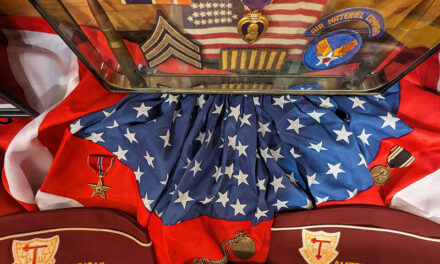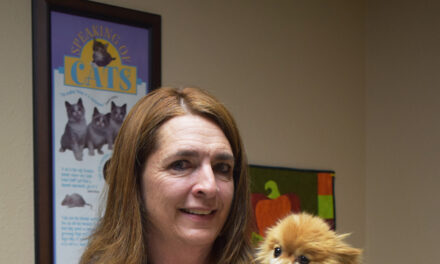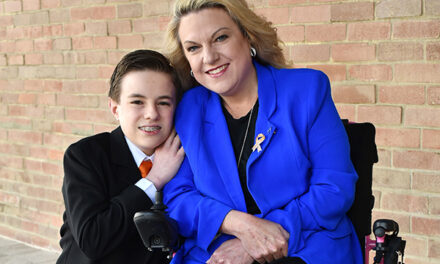La Historia del Rio Abajo
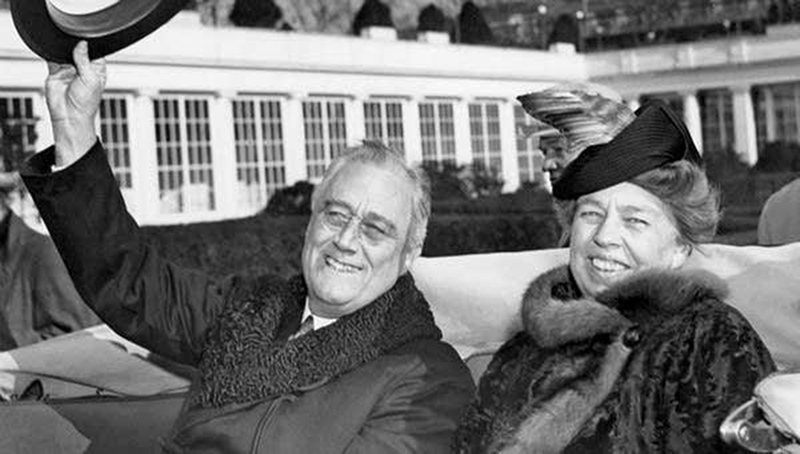
Photo courtesy of Richard Melzer
Franklin and Eleanor Roosevelt traveling by car.
Very few First Ladies visited New Mexico during its first century as a U.S. territory and state, 1850-1950.
The first, Lucy Hayes, accompanied her husband, President Rutherford B. Hayes, when, in 1880, he became the first chief executive to travel to New Mexico. Lucy was famously nicknamed “Lemonade Lucy” because of her aversion to any form of liquor.
Of the few First Ladies who have visited New Mexico, only one visited Valencia County prior to 1950. Franklin Delano Roosevelt’s wife, Eleanor Roosevelt, spent several hours in Belen and Los Lunas on Thursday, March 10, 1938.
Why did Eleanor Roosevelt visit New Mexico and specifically Valencia County during the Great Depression? What did she do here? Who did she meet? And what did she remember most about her brief historic stay?
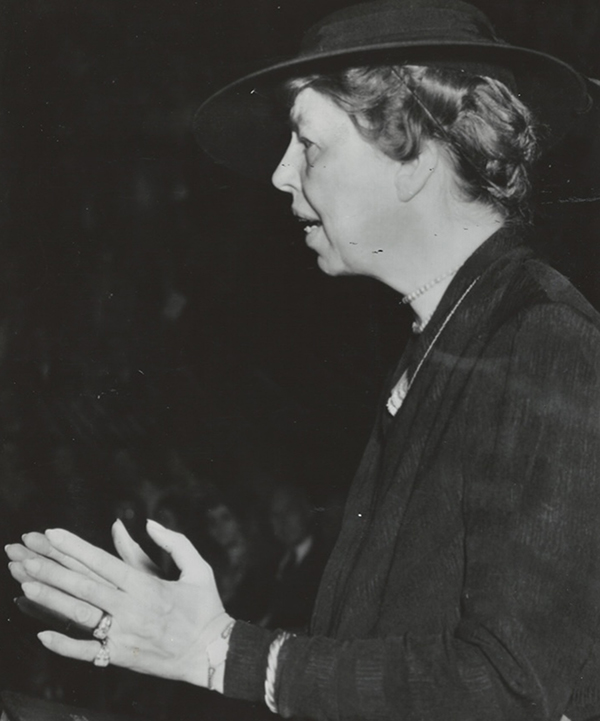
Photo courtesy of Richard Melzer
First Lady Eleanor Roosevelt speaking in Maryland weeks after she spoke at UNM, 1938.
Why did Eleanor Roosevelt travel so much?
Eleanor Roosevelt holds the record for the greatest number of miles traveled by a First Lady during her husband’s record-breaking 12 years in office, 1933-1945. She logged in more than 40,000 miles in her first year as First Lady alone.
By the spring of 1934, she appeared on the cover of a national magazine with an article titled, “America’s Most Traveled First Lady.” According to this article, she traveled by train, plane and automobile, never running low on energy, optimism or stamina.
Although FDR traveled as extensively as he could, the duties of the presidency during the Great Depression and his physical limitations as a victim of polio prevented him from traveling as much as he would have liked to to assess the nation’s needs for himself.
And so Eleanor Roosevelt often traveled in his stead, becoming his eyes and ears and reporting to FDR with extensive observations each time she returned to the White House. FDR relied on his wife as his best source of information about how Americans were managing to survive the Great Depression and how effective his New Deal programs were in helping them to do so.
Mrs. Roosevelt also became the face of her husband’s administration. A kind, generous person, she was so well received that she became one of the most admired women in the country.
Already known as an accomplished author and speaker, Eleanor’s popularity had soared by the time FDR began his second term in office in 1937. FDR could not have chosen a better surrogate or a more popular First Lady.
Eleanor Roosevelt’s fact-finding missions took her to small towns, factories, military bases, hospitals, schools and New Deal worksites across the United States. Americans liked the fact that she listened intently and usually spent more time with average citizens than with mayors, governors and other high officials.
Mrs. Roosevelt even refused Secret Survive protection so that she could meet people more personally.
She considered her travels so important to the success of any president’s administration that she supported the suggestion that a constitutional amendment should require every presidential candidate to have visited two-thirds of the states before running for office.
Arriving in Belen
On a typically long trip across the country, 53-year-old Eleanor Roosevelt had spent Wednesday, March 9, in Amarillo, Texas.
As only Texans can do, 125,000 people came out to see her, staging a 12-mile-long parade and presenting her with the world’s largest bouquet of roses, delivered on a decorated power crane.
Mrs. Roosevelt gratefully received the 5,000 roses and insisted that they be distributed to shut-ins, hospital patients and orphans in the Amarillo area.
Traveling, as she often did, on an overnight train, the First Lady arrived in Belen at 7:35 a.m. on Thursday, March 10. While waiting for her scheduled car ride to Albuquerque, Mrs. Roosevelt and her secretary, Malvina Scheider, sat at Belen’s Harvey House’s lunch counter, where they enjoyed coffee, ate rolls and chatted with the Harvey Girls on duty.
When their car arrived, the First Lady and her party headed north through Valencia County. Mrs. Roosevelt described that trip in her daily column, “My Day,” which she wrote for hundreds of newspapers, including the Albuquerque Tribune.
After viewing the Manzano and Sandia mountains, she wrote that shadows cast by the “marvelous” mountains “thrilled” her. Mrs. Roosevelt also mentioned that she traveled through Isleta, “which interested me very much” because she had never seen a pueblo before.
In Albuquerque
By 9 a.m., Mrs. Roosevelt was officially welcomed to the city of Albuquerque by a Girl Scout troop and the Albuquerque High School band at the entrance to the Franciscan Hotel. A city official presented her with a key to the city. A Life magazine photographer snapped dozens of pictures.
Mrs. Roosevelt gave a short press conference, one of dozens she faced as the president’s wife. Seldom ruffled, she fielded reporters’ questions calmly and candidly.
One reporter asked her about a rather controversial comment she had recently made regarding the need for “wife pay” in American families. The First Lady gladly explained the concept, noting that many marriages ended in divorce because women did not receive a fair share of their families’ incomes. Mrs. Roosevelt suggested couples would be wise to split whatever surplus income they might have each month.
The First Lady fielded an equally-controversial question when asked if she thought that a woman would ever be elected president of the United States. Mrs. Roosevelt replied that while there might be one in the future “no woman with any knowledge of what it means would want to be president.”
Given the extreme scrutiny they experienced, she believed that women had to be twice as good at their jobs than men with the same responsibilities.
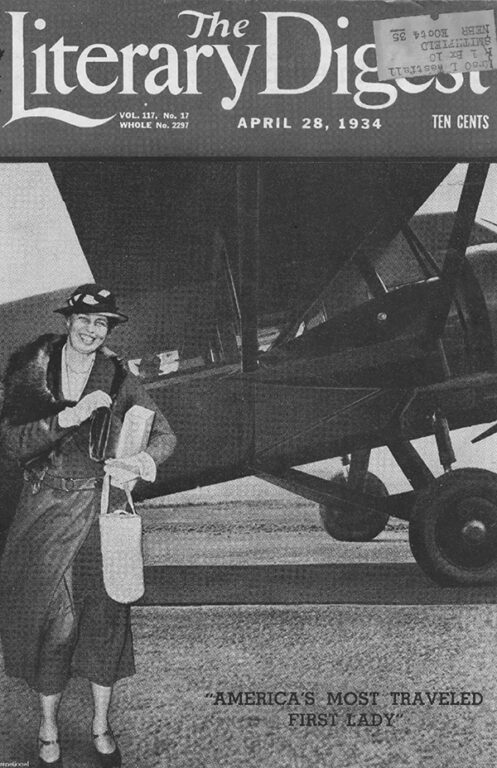
Photo courtesy of Richard Melzer
First Lady Eleanor Roosevelt on the cover of The Literary Digest, 1934.
Back to Valencia County
Having ended her press conference, Eleanor Roosevelt headed back to Valencia County by car. Her destination was a National Youth Administration (NYA) program that had been established in a Works Progress Administration (WPA) building completed on the Los Lunas High School campus in 1934.
As with all NYA New Deal projects, the project in Los Lunas was created to help train youths in trades and vocations so that they could secure jobs, earn steady incomes and lead better lives. As with most New Deal programs in New Mexico, students were taught old Spanish crafts, including furniture making, leather tanning and weaving.
The students’ best works were taken to Santa Fe and elsewhere, where they were sold “at a fair profit,” according to the press. Students were proud they had built the new tables and chairs used in the Student Union Building at the University of New Mexico.
Mrs. Roosevelt was very impressed with the NYA’s “charming building,” constructed with adobe bricks around a central courtyard. The First Lady inspected the shops and display rooms where she carefully examined and enthusiastically admired the students’ handiwork.
A small children’s orchestra trained in a NYA music program entertained Mrs. Roosevelt. Seven children from Los Chavez played several songs, including “America,” “El Rancho Grande” and “La Cucaracha.”
The Belen News reported Mrs. Roosevelt was “much pleased” with the performance.
The rest of her day
Somehow, Eleanor Roosevelt found the energy that day to travel to Santa Fe, where she made a surprise visit to a New Deal sewing project. According to the Santa Fe New Mexican, she spoke to each of the project’s 26 underemployed women, most of whom were too old to labor regularly or too young to qualify for pensions.
Mrs. Roosevelt found time to eat dinner with a friend before heading back to Albuquerque to give a lecture at UNM. An audience of 2,000 attended Mrs. Roosevelt’s presentation at the university’s Carlisle gymnasium. With Gov. Clyde Tingley and other dignitaries present, the crowd “heartily applauded” her lecture on world peace.
Newspapers reported on her suggestions to maintain peace, but seemed almost as interested in what Mrs. Roosevelt and her secretary wore, right down to the color of their corsages.
With a small police escort, Gov. Tingley and his wife, Carrie, drove the First Lady back to her hotel to await her train that evening.
Mrs. Roosevelt was said to be “still smiling and still gracious after a long, long day.”
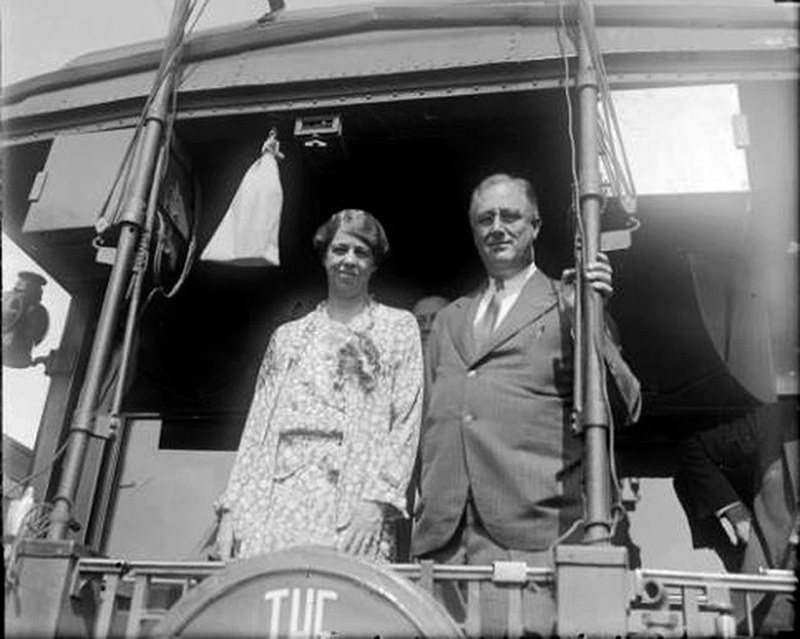
Submitted photo
Eleanor and Franklin Roosevelt traveling by train.
What she did not see
Mrs. Roosevelt saw a great deal and met many local residents during her jam-packed itinerary in Valencia County, Albuquerque and Santa Fe. But she did not have time to see all that she might have seen on her visit.
While she found Isleta to be “very interesting,” Mrs. Roosevelt did not take time to visit the first pueblo she had ever seen. And, while she must have traveled through it on her route to and from Albuquerque, Mrs. Roosevelt did not stop to visit the New Deal project in Bosque Farms.
Finally, while she expressed interest in the Carrie Tingley Hospital for crippled children in Hot Springs (now T or C), her night train from Albuquerque to El Paso gave her no opportunity to stop to see the newly-opened facility, funded with New Deal funds.
Knowing polio first-hand from her husband’s years of suffering from the terrible disease, she and the president hoped the new hospital would help many young New Mexicans recover, or at least learn to cope with their affliction.
Reporting back to FDR
We could hope to have been a proverbial fly on a wall in the White House when Eleanor returned home and reported to FDR about her day in New Mexico.
She probably focused on the successful NYA program she inspected in Los Lunas, the sewing project she visited in Santa Fe and the warm reception she received when she spoke of international peace at UNM.
New Mexicans did not offer the First Lady long parades or thousands of roses, but they did offer her what made their state more attractive than any other she would ever visit. They offered Eleanor Roosevelt simple serenity, natural beauty and a love for their native cultures — more than enough to impress the First Lady and other famous visitors to New Mexico.
(La Historia del Rio Abajo is a regular column about Valencia County history written by members of the Valencia County Historical Society since 1998.
Opinions expressed in this and all columns of La Historia del Rio Abajo are the authors’ alone and not necessarily those of the Valencia County Historical Society or any other group or individual.)
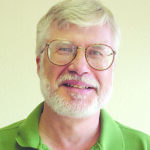
Richard Melzer, guest columnist
Richard Melzer, Ph.D., is a retired history professor who taught at The University of New Mexico–Valencia campus for more than 35 years. He has served on the board of directors of the Valencia County Historical Society for 30 years; he has served as the society’s president several times.
He has written many books and articles about New Mexico history, including many works on Valencia County, his favorite topic. His newest book, a biography of Casey Luna, was published in the spring of 2021.
Those interested in joining the Valencia County Historical Society should contact Dr. Melzer at [email protected].
